The global PVPP beer stabilizer market is valued at USD 106.8 million in 2025. It is slated to reach USD 161.1 million by 2035, recording an absolute increase of USD 54.3 million over the forecast period. This translates into a total growth of 50.8%, with the market forecast to expand at a compound annual growth rate (CAGR) of 4.2% between 2025 and 2035. The overall market size is expected to grow by nearly 1.51X during the same period, supported by increasing demand for beer clarity and shelf life enhancement, growing adoption of polyvinylpolypyrrolidone technology in brewing operations, and rising emphasis on product quality and flavor stability across craft breweries, commercial brewing facilities, and specialty beer production operations.
Between 2025 and 2030, the PVPP beer stabilizer market is projected to expand from USD 106.8 million to USD 131.2 million, resulting in a value increase of USD 24.4 million, which represents 44.9% of the total forecast growth for the decade. This phase of development will be shaped by accelerating craft beer production and premium beer segment expansion, rising adoption of advanced filtration technologies, and growing demand for natural beer stabilization methods. Breweries and beverage manufacturers are expanding their stabilization capabilities to address the growing demand for clarity enhancement solutions that ensure product consistency and extended shelf life without compromising flavor characteristics.
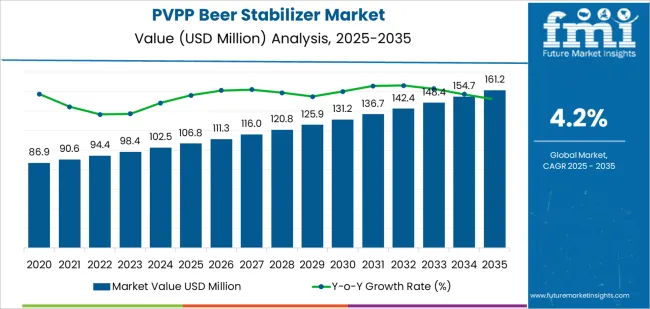
From 2030 to 2035, the market is forecast to grow from USD 131.2 million to USD 161.1 million, adding another USD 29.9 million, which constitutes 55.1% of the overall ten-year expansion. This period is expected to be characterized by the expansion of specialty and flavored beer production, the development of advanced PVPP formulations with improved efficiency characteristics, and the growth of export-oriented brewing operations requiring extended product stability. The growing adoption of quality assurance programs and international brewing standards will drive demand for PVPP stabilizers with enhanced performance and consistent batch-to-batch reliability.
Between 2020 and 2025, the PVPP beer stabilizer market experienced steady growth, driven by rising beer consumption and the growing recognition of PVPP technology as an effective solution for polyphenol removal and haze prevention in beer production. The market developed as brewmasters and quality control managers recognized the potential for PVPP stabilizer technology to enhance beer clarity, prevent chill haze formation, and support quality objectives while meeting consumer expectations. Technological advancements in PVPP production and application methods have underscored the critical importance of maintaining flavor neutrality and processing efficiency in brewing operations.
| Metric | Value |
|---|---|
| Estimated Value in (2025E) | USD 106.8 million |
| Forecast Value in (2035F) | USD 161.1 million |
| Forecast CAGR (2025 to 2035) | 4.2% |
Market expansion is being supported by the increasing global demand for high-quality beer products driven by consumer preferences for clarity and flavor stability, alongside the corresponding need for stabilization technologies that can prevent haze formation, enable extended shelf life, and maintain sensory characteristics across commercial breweries, craft beer operations, and specialty brewing facilities. Modern brewmasters and production managers are increasingly focused on implementing PVPP stabilization solutions that can improve product appearance, enhance quality consistency, and provide reliable performance in diverse brewing conditions.
The growing emphasis on product quality and shelf life extension is driving demand for PVPP stabilizers that can support polyphenol removal, enable chill haze prevention, and ensure comprehensive flavor protection. Brewery operators' preference for stabilization methods that combine processing efficiency with flavor neutrality and cost-effectiveness is creating opportunities for innovative PVPP implementations. The rising influence of craft beer proliferation and premium beer segment growth is also contributing to increased adoption of stabilizers that can provide superior clarity performance without compromising beer character or brewing tradition.
The market is segmented by product type, application, and region. By product type, the market is divided into pure PVPP and mixed. Based on application, the market is categorized into original beer, white beer, dark beer, and other. Regionally, the market is divided into East Asia, Europe, North America, South Asia, Latin America, Middle East & Africa, and Eastern Europe.

The pure PVPP segment is projected to maintain its leading position in the PVPP beer stabilizer market in 2025 with a substantial market share, reaffirming its role as the preferred formulation for effective polyphenol binding and haze prevention applications. Breweries and beverage manufacturers increasingly utilize pure PVPP for its superior adsorption capacity, straightforward application characteristics, and proven effectiveness in removing tannins and polyphenols while maintaining flavor integrity. Pure PVPP technology's proven effectiveness and processing versatility directly address the industry requirements for reliable stabilization and established performance record across diverse beer styles and production volumes.
This product configuration forms the foundation of modern beer stabilization processes, as it represents the material with the greatest contribution to clarity enhancement and established reliability record across multiple brewing applications and beer categories. Brewing industry investments in quality improvement continue to strengthen adoption among commercial breweries and craft producers. With quality pressures requiring improved shelf life and visual appeal, pure PVPP aligns with both performance objectives and processing requirements, making it the central component of comprehensive beer stabilization strategies.
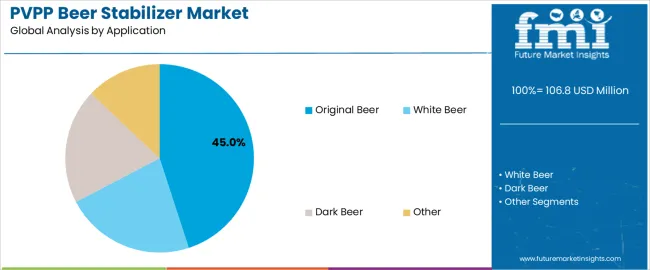
The original beer application segment is projected to represent the largest share of PVPP beer stabilizer demand in 2025, underscoring its critical role as the primary driver for stabilizer adoption across lager production, pale ale brewing, and standard beer manufacturing serving mainstream consumer markets. Breweries prefer PVPP stabilizers for original beer applications due to their exceptional clarity enhancement capabilities, flavor neutrality characteristics, and ability to prevent protein-polyphenol haze while supporting shelf life extension and quality consistency. Positioned as essential additives for modern beer production, PVPP stabilizers offer both appearance advantages and quality benefits.
The segment is supported by continuous expansion in beer production volumes and the growing availability of optimized PVPP grades that enable superior clarity performance with minimal flavor impact and efficient processing characteristics. Additionally, breweries are investing in comprehensive quality control programs to support increasingly demanding consumer expectations and distribution channel requirements for product stability. As beer market complexity accelerates and quality standards increase, the original beer application will continue to dominate the market while supporting advanced stabilization protocols and clarity optimization strategies.
The PVPP beer stabilizer market is advancing steadily due to increasing demand for beer quality enhancement driven by consumer clarity expectations and growing adoption of advanced brewing technologies that require specialized stabilization materials providing effective haze prevention and extended shelf life benefits across commercial breweries, craft beer operations, and specialty brewing facilities. The market faces challenges, including processing costs and equipment investment requirements, competition from alternative stabilization methods and enzyme-based treatments, and application complexity related to dosage optimization and processing parameter control. Innovation in PVPP regeneration technologies and application efficiency improvements continues to influence product development and market expansion patterns.
The growing proliferation of craft breweries and specialty beer production is driving demand for specialized stabilization solutions that address unique brewing requirements including small batch processing, diverse beer styles, and premium quality positioning for niche consumer segments. Craft beer applications require effective PVPP stabilizers that deliver superior clarity across multiple beer varieties while maintaining artisanal character and cost-effectiveness. Craft brewers are increasingly recognizing the competitive advantages of PVPP integration for product quality enhancement and market differentiation, creating opportunities for innovative stabilizer formulations specifically designed for small-scale brewing operations and specialty beer production.
Modern brewing facilities are incorporating advanced PVPP application systems and regeneration technologies to enhance processing efficiency, reduce material costs, and support operational optimization through automated dosing equipment and material recovery capabilities. Leading breweries are developing integrated stabilization systems, implementing PVPP regeneration protocols, and advancing technologies that enable multiple-use cycles and minimize waste generation. These technologies improve cost-effectiveness while enabling new operational capabilities, including automated quality control, real-time monitoring, and predictive maintenance scheduling. Advanced system integration also allows brewery operators to support comprehensive efficiency objectives and operational excellence beyond traditional stabilization attributes.
The expansion of flavored beer production, low-alcohol beverages, and specialty brewing operations is driving demand for advanced PVPP formulations with optimized binding characteristics and application-specific performance profiles. These specialized applications require tailored stabilizer solutions with precise polyphenol selectivity that exceed standard PVPP capabilities, creating premium market segments with differentiated value propositions. Manufacturers are investing in formulation development and application research to serve emerging specialty brewing segments while supporting innovation in flavor stability, color retention, and sensory quality preservation.
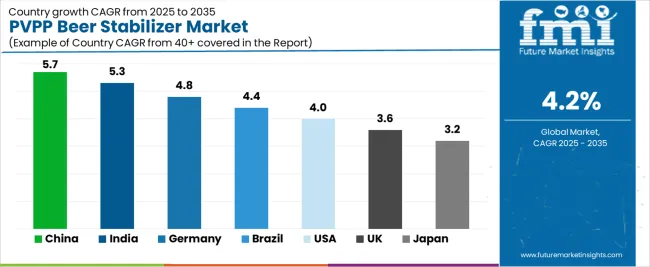
| Country | CAGR (2025-2035) |
|---|---|
| China | 5.7% |
| India | 5.3% |
| Germany | 4.8% |
| Brazil | 4.4% |
| United States | 4% |
| United Kingdom | 3.6% |
| Japan | 3.2% |
The PVPP beer stabilizer market is experiencing solid growth globally, with China leading at a 5.7% CAGR through 2035, driven by massive beer production capacity, expanding craft brewery sector, and growing consumer demand for premium beer quality. India follows at 5.3%, supported by rapid beer market growth, increasing urbanization driving beer consumption, and growing adoption of modern brewing technologies. Germany shows growth at 4.8%, emphasizing brewing excellence, craft beer innovation, and quality-focused beer production. Brazil demonstrates 4.4% growth, supported by beer market expansion, growing premium beer segment, and increasing quality awareness among consumers. The United States records 4%, focusing on craft brewery proliferation, premium beer production, and quality enhancement initiatives. The United Kingdom exhibits 3.6% growth, emphasizing craft beer development and brewing quality standards. Japan shows 3.2% growth, supported by premium beer preferences and precision brewing operations.
The report covers an in-depth analysis of 40+ countries, the top-performing countries are highlighted below.

Revenue from PVPP beer stabilizers in China is projected to exhibit exceptional growth with a CAGR of 5.7% through 2035, driven by massive beer production capacity and rapidly expanding craft brewery sector supported by rising middle-class consumption patterns and increasing quality expectations among beer consumers. The country's comprehensive brewing infrastructure and increasing emphasis on product quality are creating substantial demand for PVPP stabilizer solutions. Major breweries and beverage manufacturers are establishing comprehensive quality enhancement capabilities to serve both domestic markets and export opportunities.
Revenue from PVPP beer stabilizers in India is expanding at a CAGR of 5.3%, supported by rapid beer market growth, increasing urbanization driving beer consumption patterns, and growing adoption of modern brewing technologies in expanding brewery infrastructure. The country's comprehensive beverage sector development and changing consumption preferences are driving sophisticated stabilization capabilities throughout brewing operations. Leading breweries and beverage companies are establishing quality enhancement facilities to address growing domestic demand.
Revenue from PVPP beer stabilizers in Germany is expanding at a CAGR of 4.8%, supported by the country's brewing excellence, craft beer innovation, and strong emphasis on quality standards and traditional brewing methods enhanced by modern technologies. The nation's brewing heritage and quality consciousness are driving sophisticated stabilizer capabilities throughout brewing sectors. Leading breweries and craft producers are investing extensively in quality enhancement technologies and processing optimization.
Revenue from PVPP beer stabilizers in Brazil is expanding at a CAGR of 4.4%, supported by the country's beer market expansion, growing premium beer segment, and increasing consumer quality awareness driving demand for enhanced beer characteristics. The nation's brewing industry growth and evolving consumer preferences are driving demand for quality enhancement solutions. Breweries and beverage companies are investing in stabilization capabilities to support market requirements.
Revenue from PVPP beer stabilizers in the United States is expanding at a CAGR of 4%, supported by the country's craft brewery proliferation, premium beer production growth, and strong emphasis on quality enhancement and product consistency across diverse brewing operations. The nation's comprehensive craft beer sector and consumer quality awareness are driving demand for advanced stabilizer solutions. Craft breweries and commercial producers are investing in quality improvement technologies to serve consumer expectations.
Revenue from PVPP beer stabilizers in the United Kingdom is expanding at a CAGR of 3.6%, driven by the country's craft beer development, brewing quality standards, and emphasis on product excellence and traditional brewing methods enhanced by modern stabilization technologies. The UK's brewing culture and quality focus are driving demand for advanced stabilizer solutions. Craft breweries and traditional producers are establishing quality enhancement programs for improved product performance.
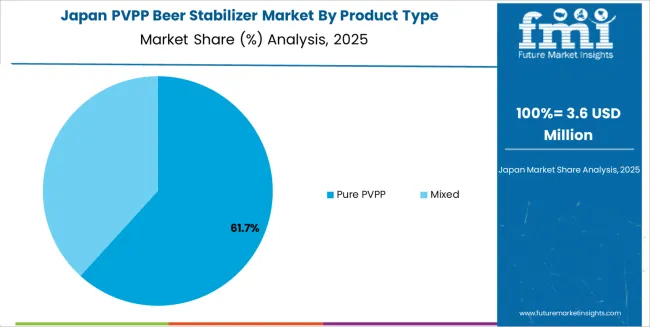
Revenue from PVPP beer stabilizers in Japan is expanding at a CAGR of 3.2%, supported by the country's premium beer preferences, precision brewing operations, and strong emphasis on product quality and visual appeal in beer production. Japan's quality consciousness and brewing precision are driving demand for high-specification stabilizer products. Leading breweries are investing in specialized capabilities for premium quality applications.

The PVPP beer stabilizer market in Europe is projected to grow from USD 38.2 million in 2025 to USD 56.5 million by 2035, registering a CAGR of 4% over the forecast period. Germany is expected to maintain leadership with a 32.4% market share in 2025, moderating to 31.8% by 2035, supported by brewing excellence, quality leadership, and advanced stabilization technology adoption.
The United Kingdom follows with 19.7% in 2025, projected at 19.4% by 2035, driven by craft beer development, brewing quality standards, and traditional brewing enhancement programs. France holds 16.2% in 2025, reaching 16.6% by 2035 on the back of brewery modernization and quality improvement initiatives. Italy commands 12.8% in 2025, rising slightly to 13.1% by 2035, while Spain accounts for 9.3% in 2025, reaching 9.7% by 2035 aided by beer market growth and brewing industry development. The Netherlands maintains 4.9% in 2025, up to 5.1% by 2035 due to craft brewing expansion and quality-focused production. The Rest of Europe region, including Nordic countries, Central & Eastern Europe, and other markets, is anticipated to hold 4.7% in 2025 and 4.3% by 2035, reflecting steady development in brewing operations and quality enhancement programs.
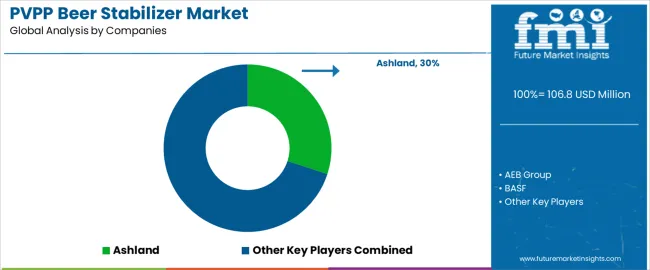
The PVPP beer stabilizer market is characterized by competition among established specialty chemical manufacturers, brewing ingredient suppliers, and diversified industrial companies. Companies are investing in PVPP production technology optimization, formulation development, application support services, and regeneration system advancement to deliver high-performance, cost-effective, and reliable beer stabilization solutions. Innovation in particle size optimization, binding capacity enhancement, and processing efficiency improvements is central to strengthening market position and competitive advantage.
Ashland leads with comprehensive PVPP stabilizer solutions focused on brewing applications, technical support services, and extensive product portfolio across diverse beer production requirements. AEB Group provides brewing specialty products with emphasis on winemaking and brewing technologies. BASF offers chemical solutions with focus on food and beverage applications including beer stabilization. Erbslöh Geisenheim delivers specialized brewing ingredients and processing aids with comprehensive technical support.
Lallemand provides fermentation products and brewing ingredients with emphasis on yeast and bacteria solutions. Huangshan Bonsun Pharmaceuticals specializes in PVPP production for beverage and pharmaceutical applications. JH Nanhang Life Sciences offers specialty chemical products for food and beverage processing. Synvent Materials Corporation focuses on advanced material solutions for industrial applications serving diverse market requirements.
PVPP beer stabilizers represent a specialized processing aid segment within brewing and beverage production applications, projected to grow from USD 106.8 million in 2025 to USD 161.1 million by 2035 at a 4.2% CAGR. These polyphenol binding agents-primarily pure and mixed PVPP configurations for multiple applications-serve as critical quality enhancement materials in original beer, specialty beer, and flavored beer production where clarity improvement, haze prevention, and flavor stability are essential.
Market expansion is driven by increasing beer quality standards, growing craft brewery proliferation, expanding premium beer segments, and rising demand for extended shelf life solutions across diverse commercial and artisanal brewing operations.
How Breweries and Beverage Producers Could Optimize Stabilization Performance?
| Items | Values |
|---|---|
| Quantitative Units (2025) | USD 106.8 million |
| Product Type | Pure PVPP, Mixed |
| Application | Original Beer, White Beer, Dark Beer, Other |
| Regions Covered | East Asia, Europe, North America, South Asia, Latin America, Middle East & Africa, Eastern Europe |
| Countries Covered | China, India, Germany, Brazil, United States, United Kingdom, Japan, and 40+ countries |
| Key Companies Profiled | Ashland, AEB Group, BASF, Erbslöh Geisenheim, Lallemand |
| Additional Attributes | Dollar sales by product type and application category, regional demand trends, competitive landscape, technological advancements in PVPP production, regeneration technology development, application optimization, and beer quality enhancement |
The global PVPP beer stabilizer market is estimated to be valued at USD 106.8 million in 2025.
The market size for the PVPP beer stabilizer market is projected to reach USD 161.2 million by 2035.
The PVPP beer stabilizer market is expected to grow at a 4.2% CAGR between 2025 and 2035.
The key product types in PVPP beer stabilizer market are pure PVPP and mixed.
In terms of application, original beer segment to command 45.0% share in the PVPP beer stabilizer market in 2025.






Full Research Suite comprises of:
Market outlook & trends analysis
Interviews & case studies
Strategic recommendations
Vendor profiles & capabilities analysis
5-year forecasts
8 regions and 60+ country-level data splits
Market segment data splits
12 months of continuous data updates
DELIVERED AS:
PDF EXCEL ONLINE
Food Grade Crosslinked Polyvinylpolypyrrolidone (PVPP) Market Size and Share Forecast Outlook 2025 to 2035
Beer Fermenter Market Size and Share Forecast Outlook 2025 to 2035
Beer Bottles Market Size and Share Forecast Outlook 2025 to 2035
Beer Dispensers Market Analysis - Size, Share, and Forecast Outlook 2025 to 2035
Beer Pasteurization Equipment Market Size and Share Forecast Outlook 2025 to 2035
Beer Glass Chillers Market Size and Share Forecast Outlook 2025 to 2035
Beer Packaging Market Size, Share & Forecast 2025 to 2035
Beer Market Analysis - Size, Share, and Forecast Outlook 2025 to 2035
Beer Keg System Market Forecast & Outlook for 2025 to 2035
Beer Dispensing Machine Market Trends - Growth, Demand & Analysis 2025 to 2035
Beer Bottling Kit Market Insights by Equipment, Application, Mode of Operation, Distribution Channel, and Region 2025 to 2035
Beer Line Cooling System Market Trend Analysis Based on System, Application, and End-Use, and Region 2025 to 2035
Beer Line Cleaning Kit Market Trend Analysis Based on Product, End-User, Type, and Region 2025 to 2035
Beer Filter System Market insights by Equipment Type, Type, Filtration Process, Application, and Region 2025 to 2035
Market Share Insights for Beer Bottles Providers
Assessing Beer Canning Machines Market Share & Industry Trends
Competitive Overview of Beer Glassware Market Share
Beer Brewing Machine Market
Beer Cans Market
Beer Stabilizers Market Size and Share Forecast Outlook 2025 to 2035

Thank you!
You will receive an email from our Business Development Manager. Please be sure to check your SPAM/JUNK folder too.
Chat With
MaRIA